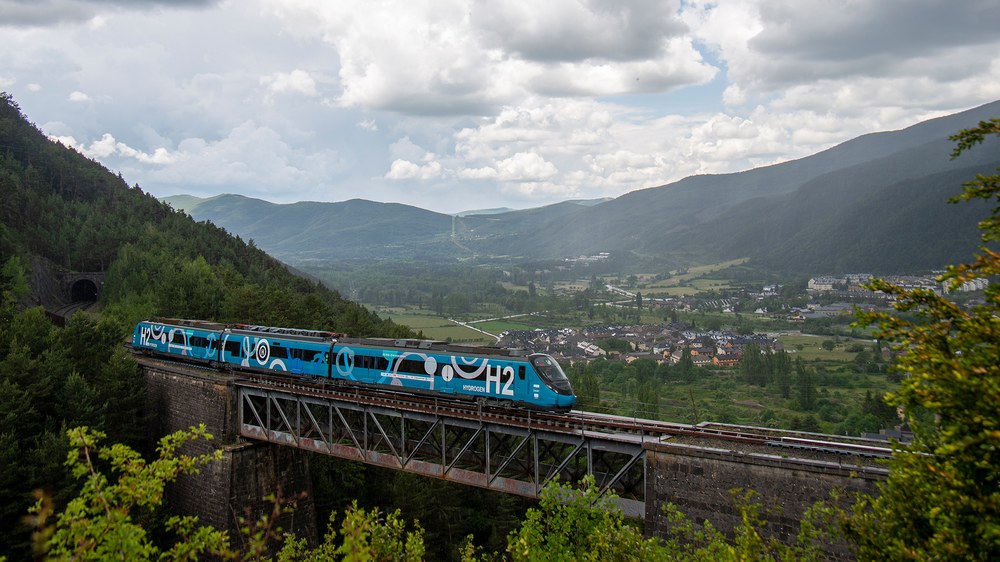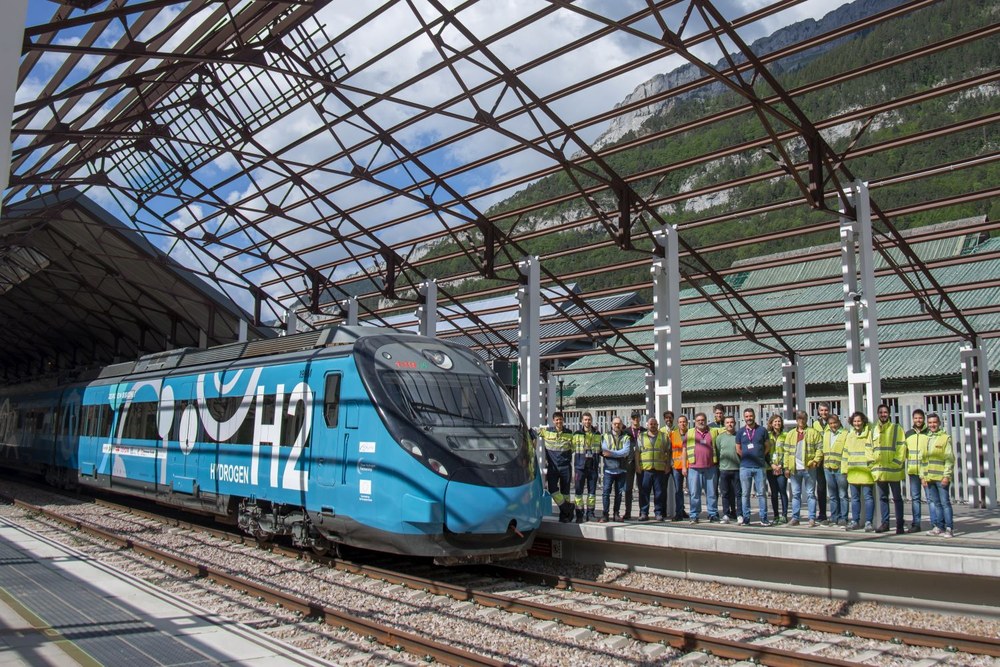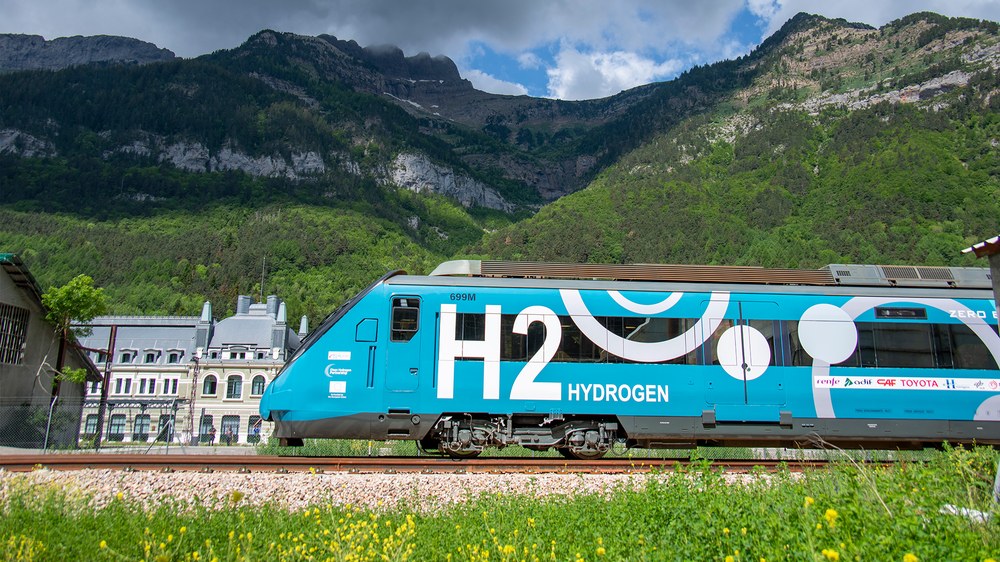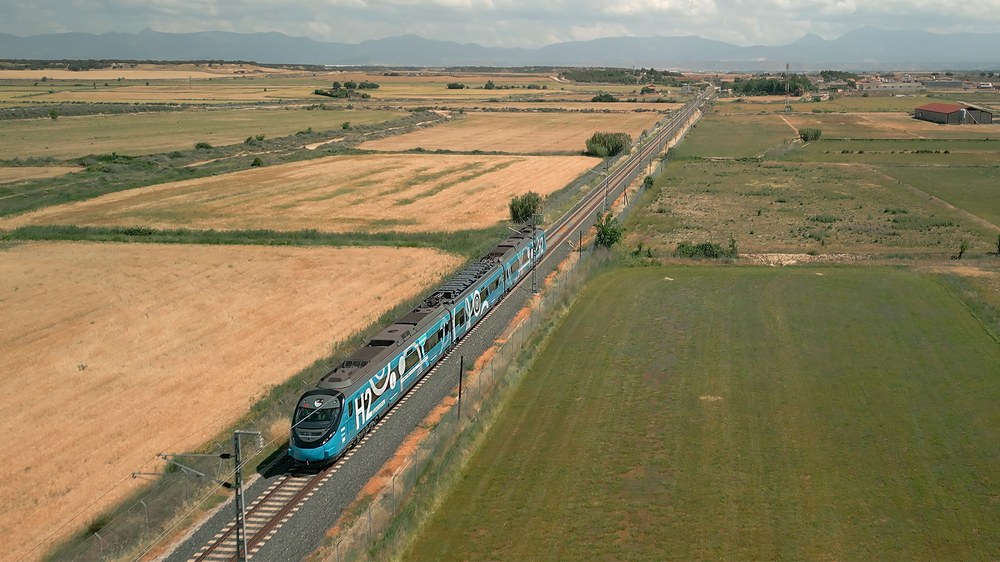In the FCH2Rail project, research and industry developed a bimodal demonstration train with hydrogen fuel cells. The project reached an important milestone with the approval of test runs on the Spanish railway network and the first long-distance journey to Canfranc in the Aragonese Pyrenees. This was a particular highlight, as the railway line to Canfranc was a particularly demanding route due to its steep gradients, which posed a major challenge for the new power generation systems. The demonstration train was built on a CIVIA commuter train from Renfe, which was able to run with zero local emissions both in electric mode on lines with overhead lines and in hybrid mode using electricity from a system of hydrogen fuel cells and batteries.
Motivation
Half of the railway lines in the European Union were electrified at the start of the project and already enabled locally emission-free local transport at that time. Diesel-powered trains were in use on the remaining sections of track. However, the construction of overhead lines was very expensive, complex and time-consuming. In addition, the realisation depended on the local geographical conditions. The range of purely battery-electric trains was around 30 to 100 kilometres, depending on the route profile and outside temperatures. Conventional diesel vehicles were limited in terms of maximum speed and acceleration compared to electric trolleybuses.
In the EU project FCH2RAIL (Fuel Cell Hybrid Power Pack for Rail Applications), the consortium with participants from Belgium, Germany, Spain and Portugal developed and tested a new type of train. The centrepiece was a hybrid, bimodal drive that combined the power supply from the overhead line with an on-board hybrid power pack consisting of fuel cells and batteries that is independent of the overhead line.
Overhead line and hybrid system: bimodal, emission-free travelling
The basic idea was: on electrified lines, the train drew its power for travelling from the overhead line. On routes without overhead lines, a fuel cell battery system, the "Fuel Cell Hybrid Power Pack", supplied the traction current. "We wanted to show that such a bimodal power system is a competitive and environmentally friendly alternative to diesel propulsion," said Holger Dittus, project manager and employee at the Institute of Vehicle Concepts at the German Aerospace Centre (DLR).
"Our bimodal fuel cell-battery system combines the advantages of both electrical technologies. This allows us to make rail transport even more sustainable and energy-efficient," says Eva Terron, Technical Project Manager at Construcciones y Auxiliar de Ferrocarriles (CAF), summarising the main objective of the project.
Scalable drive unit for efficient production
The hydrogen train's energy supply was designed in such a way that the power and range could be expanded according to the operator's application profile using a modular system. The drive power scaled with the number of fuel cell and battery modules, while the number of hydrogen tanks determined the range on non-electrified routes. This allowed the drive unit to be optimised for use in both passenger and freight transport. The modular design also made it possible to produce the required components in larger quantities and therefore more cost-effectively.
CAF had installed a new power generation system in Renfe's commuter train, which generated electricity using a hybrid of hydrogen fuel cells and batteries. The innovative system was integrated into the vehicle's existing drive system.
After a static test phase at the CAF plant in Zaragoza and the first hydrogen refuelling, the first test drives on a closed route began in mid-2022. This allowed the hybrid drive system to be optimised before the first long-distance journeys on representative routes of the Spanish rail network.
A new test phase began in 2023. The start of this test phase marked the first authorisation from Adif to operate a hydrogen train on the Spanish railway infrastructure. The hydrogen train had passed all risk analyses and safety validations to test the new technology. At the same time, Renfe had trained the train drivers and train managers to drive the converted CIVIA train. The aim was to test the new technology across a wide range of power and energy requirements, simulating different commercial multiple unit services. To this end, the train was used on various routes of the Spanish railway network in Aragon, Madrid and Galicia. The test scenarios included journeys under different climatic and operational conditions. This made it possible to comprehensively characterise the new on-board technology and assess the competitiveness of the innovative bimode hybrid drive with hydrogen fuel cells as a sustainable alternative to diesel traction.
Put on the rails: functional tests with a converted commuter train
The test runs began with the questions of which railway lines in Spain and Portugal would be suitable and what environmental impact such a system would have, from production to utilisation and disposal. In order to answer these questions with the help of tests under real conditions, the Spanish rail vehicle manufacturer CAF installed a fuel cell hybrid unit in an electric commuter train of the CIVIA series. The train was provided by the Spanish state railway Renfe Operadora. The central components were fuel cell systems from Toyota Motor Europe (TME). With the support of the infrastructure operators Administrador de Infrastructuras Ferroviarias (Adif) and Infraestruturas de Portugal (IP), initial functional tests and test runs were carried out for approval on Spanish and Portuguese lines. The Spanish hydrogen research centre Centro Nacional de Hidrógeno (CNH2) had built a hydrogen filling station to refuel the prototype.
Design and control of the system, energy management and authorisation
Before the first test drives, the international project team had to solve numerous technological challenges. The fuel cell and battery modules had to be combined and controlled in such a way that the system met all requirements and could also be realised cost-effectively. It also had to be possible to utilise the waste heat from the fuel cells to heat and air-condition the train. The air conditioning system manufacturer Faiveley / Stemmann Technik (STT) and DLR had investigated innovative solutions to minimise the energy required for heating, ventilation and air conditioning. Stemmann also analysed the interaction of the pantograph system with the hydrogen systems.
Another critical point was the safe interaction between hydrogen technology and the overhead line at all times. Sparks could occur on the overhead line, so all safety precautions had to be taken together with the hydrogen operation. The project therefore analysed norms and standards in the areas of hydrogen and rail transport and attempted to bring the two together. On this basis, the project team developed proposals for the approval authorities so that such trains can be approved quickly and easily throughout the EU in the near future.
About the project consortium
The FCH2Rail consortium included participants from research and industry: CAF, DLR, Toyota, Renfe, Adif, CNH2, IP and Stemmann-Technik. The success of the project confirmed and strengthened the commitment of the companies in the FCH2RAIL consortium to the development of environmentally friendly mobility solutions. Likewise, during the test phase, the project counted on the collaboration of companies such as IBERDROLA for the supply of green hydrogen for the test drives, SHIE-ARPA, which provided a hydrogen refuelling solution, and Ercros, which enabled the use of its facilities in Sabiñánigo during the test phase between Sabiñánigo and Canfranc.
The project is subsidised with 10 million euros by the Fuel Cells and Hydrogen 2 Joint Undertaking (FCH 2 JU, now Clean Hydrogen Partnership).
We want to show that such a bimodal power pack is a competitive and environmentally friendly alternative to diesel propulsion
Duration
01/2021 - 06/2025
Partners
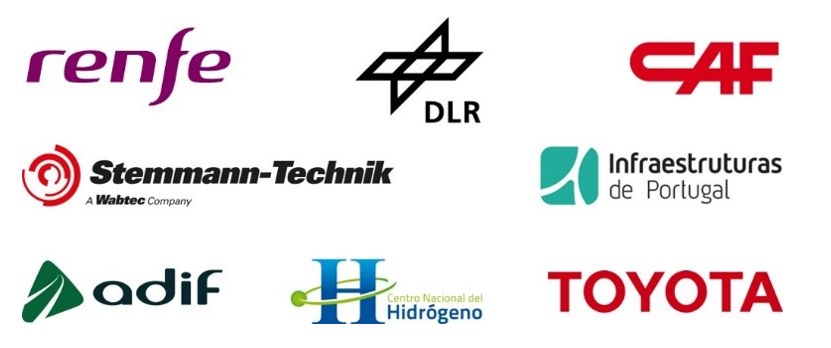
FCH2RAIL

